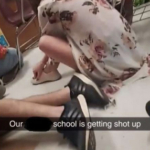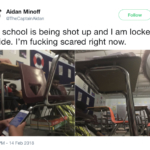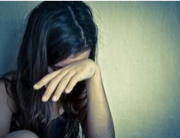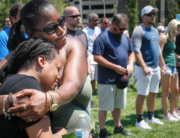SOCIAL MEDIA & SHOOTINGS
5 Ways To Help Your Children Cope
Yesterday in Parkland, Florida at Douglas High School, violent content began to flood social media as a teenager began murdering students and adults in his former school killing 17 people.
Young people like Aidan Minoff posted on social media, “My school is being shot up and I locked inside. I’m fucking scared right now. Social media gave us a look at the horrors in real time on Twitter and Snapchat of what the children and adults were facing.
 The loop of rapid gunfire and children screaming, “Oh God! Oh God,” on Snapchat as SWAT teams tried to evacuate the school are forever ingrained in our hearts and minds.
The loop of rapid gunfire and children screaming, “Oh God! Oh God,” on Snapchat as SWAT teams tried to evacuate the school are forever ingrained in our hearts and minds.
As an adult woman, I am better equipped to process this imagery than my 13-year-old daughter. But she, like millions of other young people are on social media watching it unfold day-after-day. It begs the question, “How can we help them cope when tragedy is lived out on social media?” According to Peter Lorain, “Adolescence is a critical time for brain growth.
Significant intellectual processes are emerging. Adolescents are moving from concrete to abstract thinking and to the beginnings of metacognition (the active monitoring and regulation of thinking processes). They are developing skills in deductive reasoning, problem solving, and generalizing.” The key word here is developing – not developed.
5 tactics from experts to help young people when a crisis unfolds on social media.
- QUELL OVER EXPOSURE: Here is what Amanda Lenhart, an expert on teens and technology who now works as the deputy director of the Better Life lab at New America, a Washington think tank, said about social media to Education Week: “It brings us all so immediately to these experiences, but it can do so in a remarkably unfiltered way, and it can have a traumatic impact, even on people who weren’t directly involved.” Children with high levels of exposure to violence (either as a witness or a victim), report the highest levels of depression, anxiety and anger. We must remind our children and ourselves to “turn it off and take a break.”
- OPEN A DIALOGUE: Pamela Ramsden, a lecturer in psychology at the University of Bradford in the U.K. and the author of an influential 2015 study on the topic, told Education Week via email: “Most adolescents now have their own smartphones and social media accounts. In those cases, Lazzaro said, parents and educators should expect their children will be engaging with online content about the shooting, and they should be alert to opportunities to help kids talk about what they’ve encountered.” Our children will face fear or anxiety from graphic content they see online, thus to help your kids manage, it is critical to talk to them about how they are feeling. Unfortunately, we can never assure them this will not happen at their school. However, we do have the ability to share with them safeguards in place at their schools and tactics to protect themselves that will help them to feel calmer and safer. Keep an open dialogue.
- SPEAK TRUTHFULLY: As parents it is our job to prepare not scare our children for the world we live in. It is up to us to share accurate yet age appropriate information with our children regarding violence. Social media is snippets and soundbites. We must tell a more well-rounded truth regarding events like the shooting at Douglas High School. When we speak in truths and accuracy, we limit a child from searching online for answers and finding the worst. Ms. Ramsden details how viewing violence on social media “has the ability to traumatize us” and “cause further damage to people who are actually safe and not involved.” Encourage your children to talk to you or other adults that they trust in their lives to help process and proceed positively. Keep the dialogue accurate and age appropriate.
- MONITOR SOCIAL: Many kids will turn to their friends and social media to share their opinions and their fears. The NSCA states: “As a result, it’s almost certain that most adolescents, and even many younger children, will turn to social media to share their anger and search for comfort and process their fear and grief.” During times of crisis it is important to respect our children’s privacy but also protect and inform them. This means having healthy boundaries regarding what your child is sharing on social media while being sensitive to the unique needs and concerns that arise during times of extreme violence on social media. Education Week also recommends, “Rather than directly monitoring their (your) children’s or students’ feeds, parents and teachers can empower mutually trusted third parties—friends, an older cousin—to keep an eye out for warning signs, and coach them on how to ask for help if it’s needed.”
- STAY POSITIVE: During times of heartbreaking and senseless violence it is easy for even the most mature adults to become frustrated and filled with despair. It is important for us all to remember to share love, life and hope on social media and in our homes. Experts concluded that when dealing with social media, “It’s important to remember that for all its faults, social media is a modern way of creating community. While it may have a terrifying propensity to amplify fear and facilitate obsessive and hurtful behaviors, it also has a wonderful capacity to connect people and share information and inspiration, even amid tragedy.”
Today we can only hope and pray that out of all of this senseless and horrific darkness will come light and with that light we hope will come change.
Resources & Attributed Content: To learn more about viewing violence on social media read: Pamela Ramsden 2015 study on the topic. Visit: The National Association of School Psychologists on social media, crisis and schools. Visit: Education Week.












